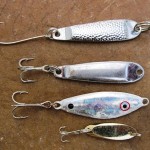
Light tackle jigging (LTJ) is one of the most popular saltwater fishing techniques. Jigging can be effective for catching a variety of saltwater fish species. A variety of lures are popular, including metal slab jigs, bucktails, soft plastics, and other rigs. In the Chesapeake Bay and Virginia’s coastal bays anglers jig for rockfish (striped bass), white perch, bluefish, flounder, trout, Spanish mackerel, and other species.
A successful light tackle jigging trip usually begins by studying charts or maps of the areas to be fished. Jigging can be productive along channel edges, oyster bars, reefs, tidal rips, and other structure. Tides and currents are also important when jigging. Fast running currents make jigging near impossible. Slack tides can also be unproductive as fish often stop biting. In between the two events, peak fishing often occurs.
Light tackle jigging is sometimes done by following flocks of gulls and other birds. Although frustrating at times, this technique can yield results. Inexperienced anglers often move from flock to flock, only to find the fish have moved each time they arrive.
A more effective strategy at times is to watch for a general pattern of movement and then slowly approach a school of fish from upwind or upcurrent. Although the birds may move away at a moment’s notice, fish often remain below. By patiently jigging these areas at lower depths, anglers often catch striped bass, weakfish, or other species.
This technique relies on a key element of fish behavior. When schools of fish push bait to the surface, the upper water column is often dominated by small stripers, bluefish, and other species. Often undetected by onlookers and surface casters are larger fish that shadow the school. The fish below feed on injured baitfish that sink to the bottom. The action of struggling baitfish is exactly what light tackle jigs must accomplish in order to be effective.
Anglers use a variety of lures for light tackle jigging. Metal slab jigs are the most common, although other types of jigs are effective. Jigs are usually selected that are similar in size to baitfish. In most areas, bay anchovies are the most abundant baitfish. Lure weight can be critical when light tackle jigging, especially when currents are strong. Most anglers stock several sizes of metal slab jigs and other lures, each being designed for a specific range of currents and depths.
When strong currents warrant additional weight, some anglers resort to using tandem rigs. These special rigs combine two lures, either twins, or unbalanced, on a single outfit. Some tandem rigs are useful when extra weight is not a requirement. These lighter rigs combine two light jigs, or possibly a weighted jig with a soft plastic body, fly, or other specialized lure. The pairing of two lures on a single line has countless variations and is known for being extremely effective.
Tandem jigs are usually most effective when jigged vertically. Their movement mimics fleeing baitfish, which in turn triggers fish to attack one or both lures. Another popular tandem rig design combines a large bucktail or other jig with a much smaller lure. When jigged properly, the rig looks much like a small fish chasing its prey.
When light tackle jigging, only basic outfits are needed in most conditions. Anglers typically choose spinning or baitcasting outfits rated for 10-20 pound line. Graphite rods are preferred as most are stiff, yet very sensitive. As with most saltwater applications, the use of braided line for light tackle jigging is debated.
Braids, although difficult to use, offer several advantages for jigging. Braided lines cut through the water much more effectively than mono, allowing anglers to jig at greater depths and in higher currents. Braided lines are also more sensitive which helps anglers detect light bites. Despite these qualities, braided lines have several disadvantages. They are hard to tie successfully, vulnerable to cuts, tangle easily, and are expensive to purchase.